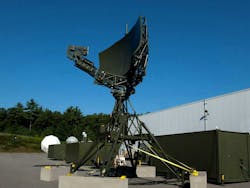Air Force asks industry to design prototype deployable air traffic control (ATC) radar for surveillance
HANSCOM AIR FORCE BASE, Mass. – U.S. Air Force air traffic control experts are reaching out to industry for a deployable and maneuverable multifunction radar system for terminal air traffic control (ATC), airspace warning, weather processing, battle management, command, and control (BMC2), and threat response.
Officials of the Air Force Life Cycle Management Center at Hanscom Air Force Base, Mass., have issued a solicitation (FA2330-24-R-0001) for the Multi-Band Multifunction Tactical Radar System (MB-MTRS) Design and Prototype project.
The MB-MTRS is to reduce the volume of logistical support for airlift, supply chains, and support personnel, and reduce electromagnetic interference from nearby systems while working simultaneously.
MB-MTRS requires radar antennas and electronics small enough for deployment and transport in no more than three 463L pallet positions on a C-130J aircraft. No more than four Air Force personnel must be able to set up the radar in four hours or less.
The radar must be transportable by military cargo vehicles, aircraft, trains, and ships without damage, must be able to withstand world-wide deployment cycles; and must be configurable to several different missions. The MB-MTRS three development phases will be initial system design; preliminary system design; and prototype demonstration.
U.S. military leaders rely heavily on expeditionary and agile joint forces that are able to deploy and operate by air transport in all weather conditions. To do this, air bases must have situational awareness and protection. This is where the MB-MTRS comes in.
The MB-MTRS deployable radar must be able to perform ATC surveillance for aircraft identification, separation, and terminal sequencing in instrument flight and visual flight rules (IFR/VFR); final approach course precision approach guidance; surveillance to detect, identify, and track hostile undeclared manned and unmanned aircraft; counter-small unmanned aircraft; and provide real-time weather sensing.
Related: Radar keeps a surveillance eye on the battlefield
The MB-MTRS also must be able to exchange real time radar data via an external interface to commercial and military air traffic control systems. It also must be designed with an open-systems approach using the Modular Open Systems Approach (MOSA) and other non-proprietary standards and common government standard interfaces.
Companies interested should upload responses with 75-page PDF files no later than 13 Nov. 2023 to the U.S. Department of Defense Safe Access File Exchange (SAFE) website at https://safe.apps.mil.
Email questions or concerns to the Air Force's Richard Williams at [email protected] and to Danielle Crone-Alvarez at [email protected]. More information is online at https://sam.gov/opp/15d467a186ef4fdda1480a53b2c309b7/view.
About the Author
John Keller
Editor-in-Chief
John Keller is the Editor-in-Chief, Military & Aerospace Electronics Magazine--provides extensive coverage and analysis of enabling electronics and optoelectronic technologies in military, space and commercial aviation applications. John has been a member of the Military & Aerospace Electronics staff since 1989 and chief editor since 1995.
